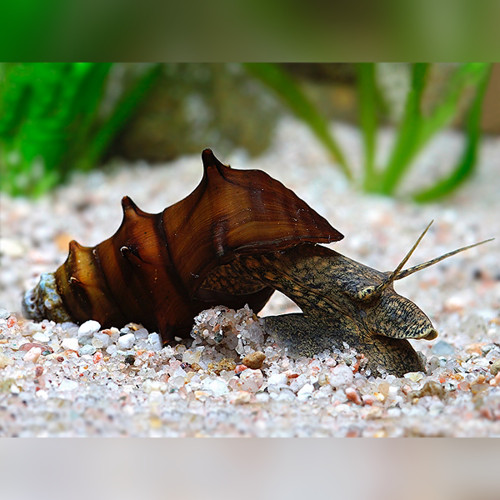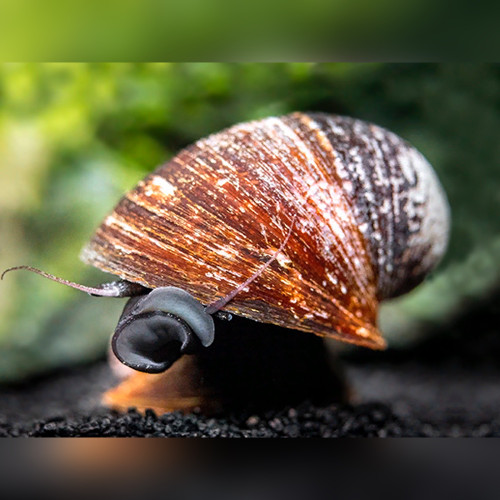Offering Pagoda Snail (Brotia pagodula).
Brotia pagodula also known as Pagoda Snail is a species of freshwater snails, which belongs to the Pachychilidae family. It inhabits rivers, streams and other shallow water bodies. This snail species is a good algae-eater and thrives in environments with favourable water and living conditions which makes it an interesting choice for home aquariums.
Knowledge of these snails still is scanty and little is known concerning details of their ecology and reproduction. According to the researcher, due to the lack of detailed systematic studies of Brotia, there is confusion as to the limits of this genus as well as its generic and familial affinities.
- Scientific Name: Brotia pagodula
- Common Names: Pagoda Snail, Horned Armor Snail, Porcupine Snail
- Tank Size (minimum): 10 Gallons (~40 litres)
- Keeping Level: Moderate to Difficult
- Breeding: Difficult, Slow
- Average Size: 3 – 5 cm (1 – 2 inches)
- Temperature: 71° – 82° F (22° – 26° C)
- Optimal pH: 7.0 – 8.0
- General Hardness: 6 – 20 dGH
- Carbonate Hardness: 5 – 15 dKH
- Total Dissolved Solids (TDS): 100 – 250 ppm
- Nitrate: less than 20 ppm
- Diet: Herbivorous / Algae Eater
- Temperament: Peaceful, Solitary
- Life Span: up to 5 years
- Color Form: Brown to Yellow
Brotia pagodula is restricted to the Thoungyin River in Thailand. This river is a tributary of the Salween River in Thailand. The river is 327 kilometers long and forms a portion of the border between Thailand and Myanmar (Burma).
Description of Brotia Pagodula
Brotia Pagodula (Pagoda snail) Brotia Pagodula is a very unique and attractive snail, it possesses these notable features:
- A light brownish to grey color with tints of amber and mahogany.
- The thick and broadly conical shell which has numerous small conspicuous spikes protruding from it in a spiral form.
- Its spire is decollated and consists of up to five flattened whorls with a spiral row of long and pointed spines.
- The whorls are separated by a narrow suture.
- Presence of a round and multispiral
- Fine lines on shell.
- Fleshy inner body with colors ranging from plain dark grey to light yellow.
- Brotia pagodula snails have a large bulky appearance with a broad and furrowed snout.
- The cephalic tentacles are moderately long.
- Brotia pagodula snails have an average size of 3 – 5 cm (1 – 2 inches).
- These snails can live up to 3 – 5 years (according to the shells analyses). However, in captivity, their lifespan can barely reach 1 – 2 year at most. The problem is the lack of care knowledge.
Pagoda snails are non-aggressive, solitary and docile by nature, liking a calm aquatic environment. peaceful tank mates. Thus they coexist peacefully with other tankmates. They have no means to attack other tank inhabitants and have only its operculum and shell for protection from aggressors.
These snails are shy and quiet, especially when newly introduced into an aquarium.
Brotia pagodula snails are nocturnal and get scared easily. They can often stay and hide in their shells for long hours without thinking of coming out. When they finally do, they come out of their shells to dig at the substrates and pick tiny food particles. Brotia pagodula is not a burrower type of snails.
Feeding Brotia pagodula
Although Brotia pagodula can feed on algae and detritus (decomposing plant and animal matter), they are mostly herbivorous. Considering the fact that this is a pretty big snail, you may need to supplement your snails’ diets.
For example, algae wafers (or tablets, pellets, fish/shrimp flakes) are good options as they will sit on the bottom of the tank and stay there until your snails come across them. Do not forget about adding green vegetables like carrot, sprouts, spinach, cucumber, zucchini. These can be fed fresh or frozen.
Note #1: It is important that you do not overfeed these snails, this causes the water to go bad easily, and it will be detrimental to their health and that of other inhabitants in the planted tank.
A balanced diet is also crucial for snail’s shell. Unfortunately, the shells' deterioration on the Brotia pagodula snails is pretty common. Therefore, adding calcium supplements can help ensure their shells are strong and healthy. Calcium supplementation should be dosed for the maintenance of their large thick shells.
Like all other species of snails, you will want to provide them with some sort of calcium supplement to help keep their shell beautiful and healthy.
Note #2: Just like other invertebrates, Brotia pagodula is sensitive to copper and copper compounds. Therefore when purchasing aquarium fertilizers ensure that they do not contain copper-based chemicals. The same should be the case when feeding the snails, ensure that the food ingredients do not contain copper or copper sulphates.
Are Brotia pagodula Snails Plant Safe?
Brotia pagodula loves eating vegetables and green matter, and they are known to attack and feed on plants in the tank. However, this can be put under control by adequately feeding the snails regularly. When food is not readily available, Brotia pagodula can resort to munching on aquarium plants.
Important: Feed Brotia pagodula snails daily if you don’t want them to eat all the plants.
Keeping and Housing Brotia pagodula
These snails are not for beginners. They have some specific requirements if you want to create an ideal environment for them.
Tank size: Brotia pagodula snails need to be in an established tank with sufficient size and water volume to support its needs. For example, you need to have at least a medium-sized aquarium of 60 to 80 cm (20 – 30 inches) in length. 10 Gallons (~40 litres) is the absolute minimum tank size you can keep these snails in. Anything smaller and you will have problems.
Important: One thing that most aquarists forget or do not know is that Brotia pagodula snails live in a river with fast water flow. It is vital to have a high oxygenated tank. So you need to have a suitably sized pump in there to push the water around sufficiently. That is why bigger tanks are preferred if you want them to thrive and live longer than a few months.
Tip: If the filter flow is not strong enough, it is strongly advisable to use an additional flow pump in your tank. You do not need the secondary pump to be big and expensive, it only needs to keep a current running around the tank all the time.
Substrate: Regarding substrate, in the wild Brotia pagodula snails live attached to rocks as well as on sandy bottoms. So, provide a sandy or fine coarse substrate which serves as a resting and sifting ground for the snails where they search for food particles.
Water Parameters: This species needs to be kept in a tank with well-filtered water of soft to moderate hardness. Ensure that the water is not acidic to prevent damage to the shells (usually in form of tiny holes).
Maintain the following tank parameters for healthy growth and development of the Brotia pagodula:
Water pH should be around 7.0 – 7.5 with a high GH and KH level.
Brotia pagodula prefers to live at temperatures around 22 to 28°C (~70°F – 88°F). However, it is better to have 24 – 25°C (75 – 77°F).
Light, Decorations, etc.
The Brotia pagodula snails are not fond of light especially in a relatively new environment. They do better in a dark or very low light tank. Also, it is advisable to clear out crevices or branches in the aquarium as the snail’s shell can get stuck in it (because of the shell shape) and die as a result of stress.
Do not forget that they need careful acclimation as all invertebrates.
Mating/Breeding of Brotia pagodula
After a short courtship, it’s time for mating. The male Brotia pagodula mounts onto the shell of the female while holding it firmly. During this process; the male transfers sperms to the female.
It is hard to identify the gender of the Brotia pagodula snail so it is necessary to have at least 4 – 5 of them to ensure that both males and females are present.
Brotia pagodula exhibit viviparity (they give birth to live young ones), and can reproduce up to 10 – 20 young ones in a year. They reproduce very slowly and usually do not have more than 1 – 3 baby snails at a time.
Interesting fact: female Brotia pagodula retain shelled juveniles in a specific incubatory structure. They have a brood pouch that is located dorsally in the neck region and occupies almost the entire visceral cavity of the head foot.
According to the study, juveniles within brood pouch all of the same size, about 4 mm in height. Shells completely calcified, comprising about 3.5 whorls. Juvenile shell turreted with flattened whorls, shell texture smooth, sculptured only by faint spiral lines and regular growth lines. Apical whorl with irregularly wrinkled sculpture delimited by sharp transition after about 2/3 of the first whorl. In Brotia Pagodula the embryonic shell is asymmetrically and irregularly wrinkled.
These young snails should be feed finely powered food at least once a day to ensure their survival.
Brotia pagodula and Suitable Tank Mates
Most snails are known to be peaceful and solitary and Brotia pagodula is no exception. You need to pair it with small freshwater shrimp-like: Vampire Shrimp, Bamboo Shrimp, Amano Shrimp, Ghost Shrimp, Cherry Shrimp, Blue Tiger Shrimp, Snowball Shrimp, Caridina cf. babaulti, Blue Velvet Shrimp, etc.
Brotia pagodula snail tank mates can also include other snails including Japanese Trapdoor Snails, White Wizard Snail, Black Devil Snails, Rabbit Snails, Nerite Snails, Mystery Snails, Ramshorn snail, Malaysian Trumpet Snails and others of their kind.
Assassin Snails and Marisa cornuarietis will not be good neighbors. The first ones can harass Brotia pagodula snails. The second one will eat all the plants in the tank.
It's not advised keeping them with crayfish or crabs (except Thai Micro Crab) as well. For example, even Dwarf Mexican Crayfish, the safest out of all crayfish species, can nip off the antennae of larger snails.
In Conclusion
This snail species is a great addition to the tank in terms of aesthetics and also helps to keep the tank clean from waste.
Brotia pagodula snails can also be introduced to the home aquarium, they are good companions to dwarf shrimp and non-carnivorous fishes. They are excellent scavengers thereby helping to keep the tank algae and detritus free. However, they are not easy to keep and should not be picked by beginners.
The image used above is for illustration purposes only. Please click here to see the snail’s profile explaining the keeping and breeding conditions for this species. We offer free shipping. Please carefully check our Delivery Conditions before you place an order.










